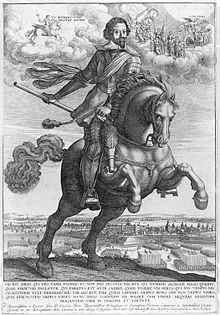Abraham Hogenberg
Abraham Hogenberg (also: Abraham Hoog [h] enbergh ) (* after 1578 in Cologne ; † after 1653 there) was a Cologne engraver and painter of the early modern period who also operated in the art trade.

Act

Little is known about his living conditions and his work. His father was probably the copper engraver Frans Hogenberg , who lives in Cologne , and his mother Agnes Hogenberg-Lomar. Their son Abraham was probably born after 1578, because he was already active in 1590, since the title page is assigned to him with "Hercules and Omphale". His history sheets appeared in 1599, such as the “Siege of Schenkenschanz by the Spaniards in April 1599” (“Fortalicium Schenckianum”). Around 1605 he took over the management of his parents' engraving from his mother Agnes Hogenberg-Lomar. In 1608 he was registered as a master in the painters' guild and later lived “under Helmschläger in the golden ring” (today's eastern part of the street Am Hof ). A painting with St. Franciska in 14 scenes from her life, only discovered by Johann Jakob Merlo in 1846, bears the signature "Abraham Hogenbergius von Cöln" (1608). After 1609 his copper engraving Schweidt appears (“Description and abrises of the Collnischen Schweidts, with its Gemercken, ways, divorces, in and surrounding villages, heuseren, lands”) about Cologne. The "Cöllnische Schweidt" are the farmers' benches with grazing rights within the city's castle ban. It contains distinctive urban buildings and streets, including the Stommeler windmill , built in 1503 . His engravings include the equestrian portrait of Ernest Margrave of Brandenburg (1611). In cooperation with the typographer Anton Hierat, he published Volume 6 of Braun's City Book ( Georg Braun ) in 1618 with a dedication by both of them on September 20, 1617. In 1627 there were several sheets for “Fama Austriaca”, the “Aacher Chronick” (1632) or the title sheet for “Atrum Inextinctum” (1636). A series of title pages depicts Antwerp (1598), Prague (1635) or “Near Strasbourg” (1635).
Other works
Abraham Hogenberg is also the "Tournament of the Spaniards in Brussels 1569", the "Battle of Gembloux (January 31, 1578)", the etching "View of Naples and Vesuvius" (1578) or the "Siege of Breda by Spinola" ( dated June 5, 1625) attributed. The copper engraving by Jan van Werth (Joannem de Weert) dates from March 2, 1635 . One of his last works is likely to be the illustration of a comet that appeared in December 1652 and was printed in 1653. The picture was not fictional, because this “extremely large” comet was visible for 20 days and was discovered on December 16, 1652 by Johannes Hevelius . According to this, Abraham Hogenberg - for the circumstances at the time - was probably very old at the age of 75.
- Various engravings appeared in Fama Avstriaca by Gaspar Ens. Von Brachel et al., Cölln 1627. ( digitized version )
family
In the Flemish Mechelen and Cologne lived a few people with the name Hoog (h) enbergh in the Middle Ages, all of them engravers or painters. The specialist literature does not agree with regard to the classification of the relationships. Remigius Hogenberg is mainly classified as the brother of Frans Hogenberg, whose father was Johann Nikolaus Hogenberg . According to popular belief, Abraham Hogenberg (1578–1653) and Johann Hogenberg († 1554 in Mechelen) were the sons of Frans Hogenberg.
Web links
Individual evidence
- ^ Biographical Index van de Benelux. 1997, p. 664.
- ↑ Friedrich Müller / Karl Klunzinger / Adolf Seubert, The Artists of All Times and Nations , 1860, p. 393 f.
- ^ Johann Jakob Merlo: News of the life and works of Cologne artists. 1850, p. 185.
- ^ Johann Jakob Merlo: News of the life and works of Cologne artists. 1850, p. 188.
- ↑ Julius Wernicke, Thorn's story from deeds, documents and manuscripts: The years 1531 - 1840 , volume 2, 1842, p. 274
| personal data | |
|---|---|
| SURNAME | Hogenberg, Abraham |
| ALTERNATIVE NAMES | Hohenberg, Abraham; Hoogenbergh, Abraham; Hooghenbergh, Abraham |
| BRIEF DESCRIPTION | Etcher and eraser |
| DATE OF BIRTH | after 1578 |
| PLACE OF BIRTH | Cologne |
| DATE OF DEATH | after 1653 |
| Place of death | Cologne |